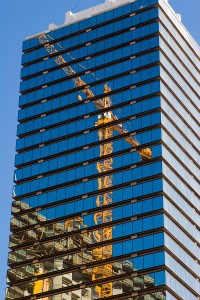Subrogating claims caused by adjacent property owners can be tricky, according to Michael Wallace, a season property subrogation attorney with New Jersey-based Stutman Law and Mark Suchecki, a consulting engineer with Plick & Associates.
Wallace and Suchecki recently presented on the subject at the Property & Liability Resource Bureau’s national conference in Indianapolis.
 According to Suchecki, one of the most common causes of property damage from adjacent properties is foundation undermining associated with earth movement, such as excavation and vibration. Another common cause of damage is related to installation of deep foundations caused by pile driving. Demolition of a neighboring building causing it to collapse can also cause damage, such as punctures and cracks in walls. Even debris removal and rebuilding can lead to property damage to neighboring buildings. In these types of situations, Wallace said there could be two claims and two occurrences.
According to Suchecki, one of the most common causes of property damage from adjacent properties is foundation undermining associated with earth movement, such as excavation and vibration. Another common cause of damage is related to installation of deep foundations caused by pile driving. Demolition of a neighboring building causing it to collapse can also cause damage, such as punctures and cracks in walls. Even debris removal and rebuilding can lead to property damage to neighboring buildings. In these types of situations, Wallace said there could be two claims and two occurrences.
Though OSHA regulations do exist relating to demolitions near adjacent properties, the rules aren’t always followed. An example, the Philadelphia building demolition that led to the collapse of a neighboring thrift shop that killed six people.
According to Wallace, some obstacles to investigating these types of losses include:
- The cause of loss occurred on adjacent property controlled by others.
- Denial of access to the property that caused the loss.
- Safety concerns and demolition orders.
- Risk of additional damage that could occur.
- The need for emergent applications to be filed in court.
In order to overcome these obstacles, Wallace recommended engaging in a thorough investigation. He offered the following steps to investigating adjacent property subrogation claims:
- Determine who controls the loss scene immediately.
- Coordinate with governmental entities to investigate the loss.
- Notice and preserve the loss scene with letters to all interested parties.
- Request the opportunity to inspect the loss scene.
- Put responsible parties on notice; give time deadline to inspect before demolition occurs.
- Retain expert, determine the role of the expert; obtain building documents, files and media reports.
- Compile videos, witness statements and OSHA reports for the retain expert. Consider obtaining construction and building department documents.
- Document spoliation issues – some jurisdictions allow this to be included in a separate count in a legal complaint.
The subrogation attorney noted that OSHA reports are usually comprehensive, containing statements of contractors and employees, photos, building documents and violations, if assessed. While OSHA reports are admissible, the federal agency is protected from testifying on civil matters.
Wallace recommended proactive claims handling. He suggested adjusters consider doing the following:
- Develop a protocol to secure scene for inspection.
- Develop a protocol for joint inspection.
- Draft release of claims/assumption of risk document ahead of time.
- Consider improving scenes by developing a shoring/bracing/security fencing plan with an expert.
If demolition is ordered, Wallace recommended making a plea to local government officials for access to the site. If unlikely, he said adjusters should consider alternative ways to investigate the loss via photos from the adjacent insured building, obtaining photos from a raised construction bucket or even using security camera footage.
Was this article valuable?
Here are more articles you may enjoy.

 Analysis Shows Wider Florida Flooding From Milton: 185,000 Buildings Hit
Analysis Shows Wider Florida Flooding From Milton: 185,000 Buildings Hit  Most Homeowners Worried About Impact of Natural Disasters and Climate Change, New Survey Shows
Most Homeowners Worried About Impact of Natural Disasters and Climate Change, New Survey Shows  J&J’s $8.2 Billion Talc Settlement Faces January Court Test
J&J’s $8.2 Billion Talc Settlement Faces January Court Test  La Niña Could Soon Arrive. What That Means for Winter Weather
La Niña Could Soon Arrive. What That Means for Winter Weather 